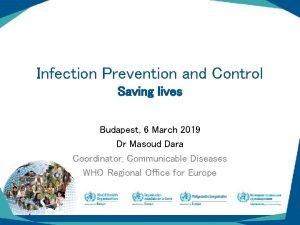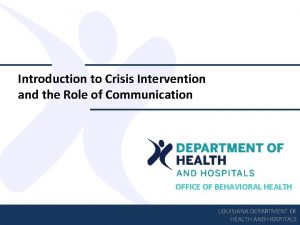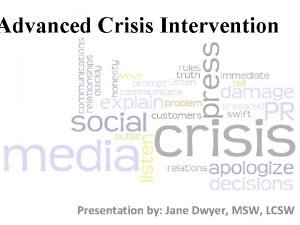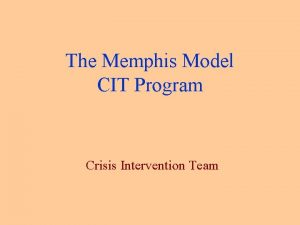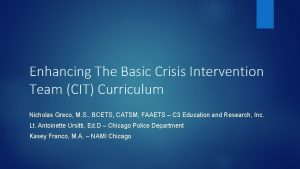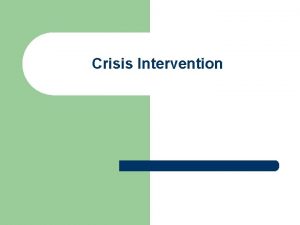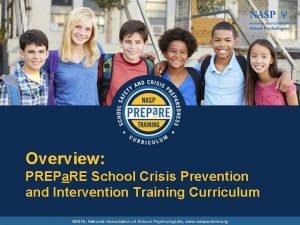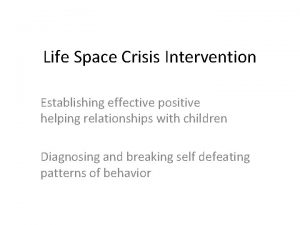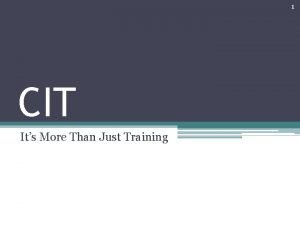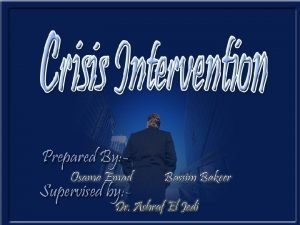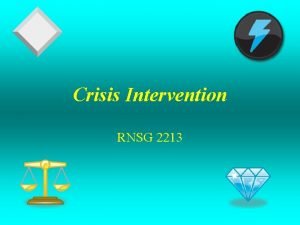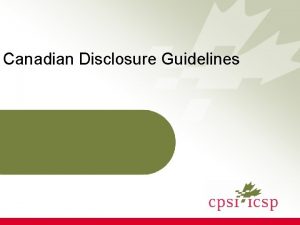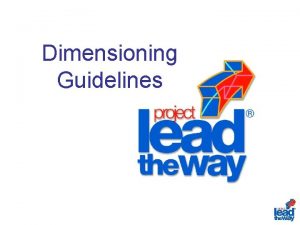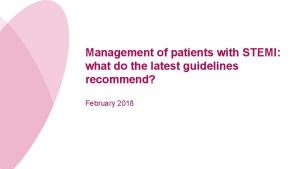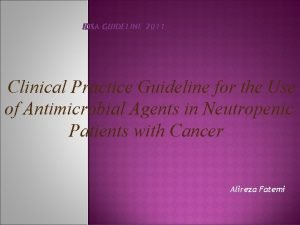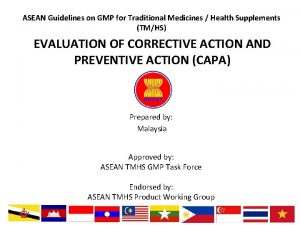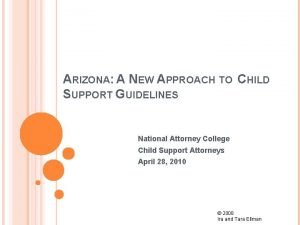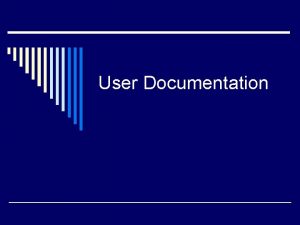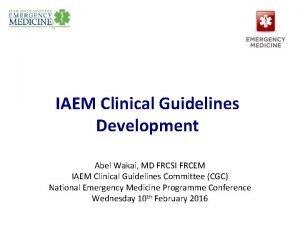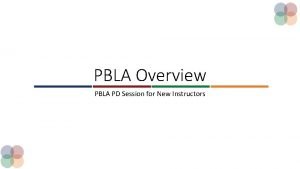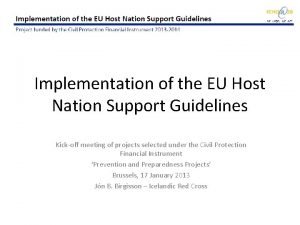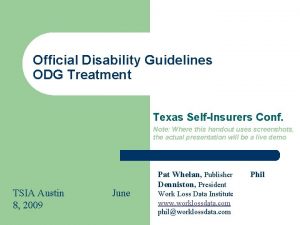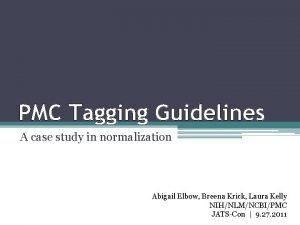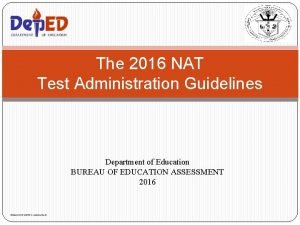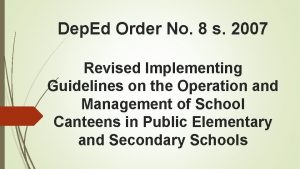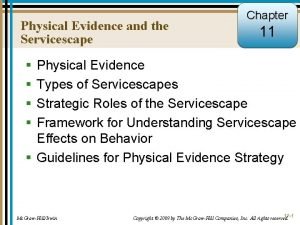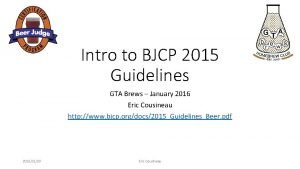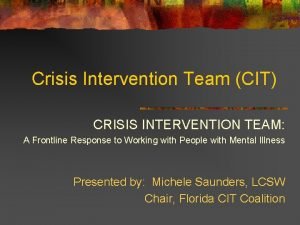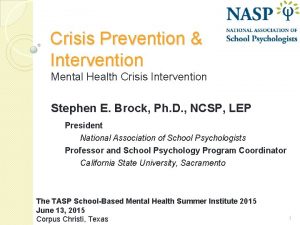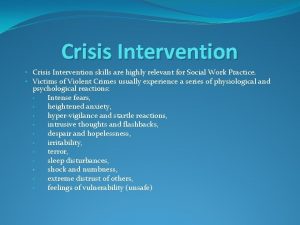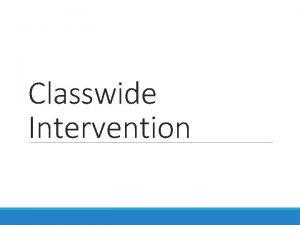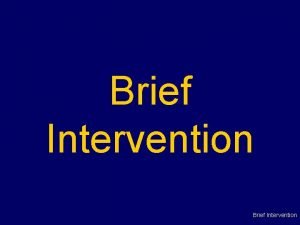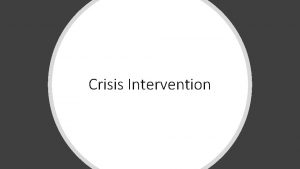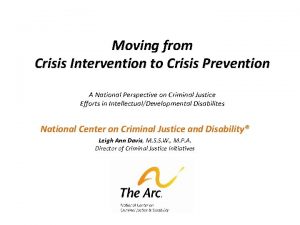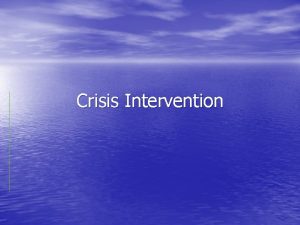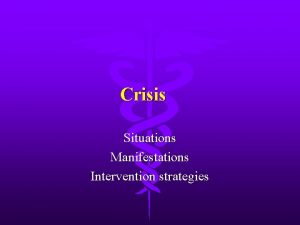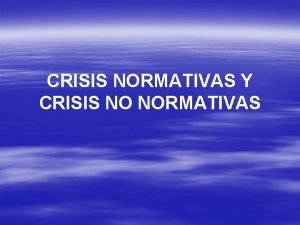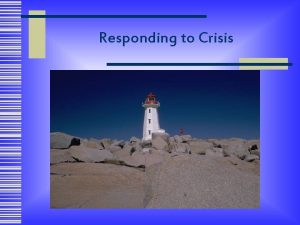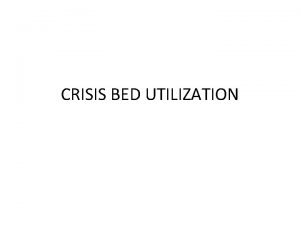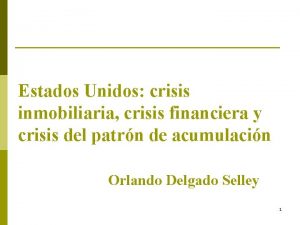CRISIS INTERVENTION Components of crisis intervention Guidelines Crisis































![Student [17 -? ] Not doing well at school n Lost scholarship n $$ Student [17 -? ] Not doing well at school n Lost scholarship n $$](https://slidetodoc.com/presentation_image_h2/fdd6c81d4774171a951f3b85a34a3f1b/image-32.jpg)
![Adult [beyond school] Job loss n 2 nd career – forced on them n Adult [beyond school] Job loss n 2 nd career – forced on them n](https://slidetodoc.com/presentation_image_h2/fdd6c81d4774171a951f3b85a34a3f1b/image-33.jpg)















- Slides: 48

CRISIS INTERVENTION Components of crisis intervention Guidelines Crisis at various stages of life Special challenges

Definition n n “the helping response of a crisis worker to a victim in crisis”. (Mitchell, Resnik) An active but temporary entry into the life situation of a person, family or group during a period of stress Paramedic needs to be alert, flexible, resourceful and willing to get involved Intervention targets the response – NOT the event per se.

Goals of crisis intervention Earmarked by narrow goals of short duration 1. Shield the person from additional stress 2. Assist the person in organizing and mobilizing their resources 3. Return the person, a much as possible, to a pre -crisis level of functioning

Five major components of crisis intervention n Intervention is flexible but structured – not haphazard or sloppy n Consider the stages the individual is going through during your intervention n Assist you [the paramedic] to decide what to do

1. Assessment n n n First priority is safety – is there any danger to you or others What has happened? Who is involved? What was the cause? How serious is the problem?

2. The plan n Preliminary plan of action based on assessment Does not need to be detailed; the crisis will not wait! Doing something positive is better than doing nothing

3. Implementation of the plan n n Act, intervene What ever the plan, get going!

4. Reassessment n n n Once a plan has been implemented, it needs to be monitored for success If the plan is working, keep going! If not, formulate a new plan

5. Recapping n n n Victims of crisis have a difficult time following what is going on around them The person may need someone to tell them what is happening This may need to be done repeatedly

Remember Most important tools are verbal and non verbal communication. Careful use of these skills will: n Help the person reduce emotional reactions n Make sense out of what is happening n Find short term solutions to the problem

Guidelines The DO’s and DON’T’s of Intervention n Application üCrisis pt üMost incidents

1. Provide a reality base n n n Be calm Identify yourself and your position Explain the presence of others such as police and fire fighters Use the person’s name Reassure the person of confidentiality Give supportive and truthful information

n n n Let the person know what you expect of them and what they can expect of you Explain why you are doing or not doing something Explain unusual equipment or procedures Anticipate the concerns of the person and family Be non judgmental Be aware of your reactions

2. Provide verbal and non verbal support n n n Maintain a relaxed posture Be near and at their level, if appropriate Touch is important, if appropriate Encourage communication Realistic reassurance with reasonable expectations Stay with them if possible

3. Listen and respond Effective listening n Attending n Paraphrasing n Reflection of feelings n Summarizing n Probing n Helper self disclosure

4. Ask clear, simple questions n n Ask open ended questions Questions should be understandable and focused One at a time A definite plan of questioning is helpful

Remember the Goal Get the person to talk freely and frankly about the present situation n Obtain background info about the problem - detail n Help the person understand about the situation n Consider if time permits alternative to resolve problems. . . usually more the crisis Interventionalist n

Precautionary Measures (the don’ts ) n 1. Don’t deny the possibility of violence when the early signs of agitation are first noticed. n 2. Don’t dismiss warnings from records, family authorities or fellow workers (dispatch). n 3. Don’t become isolated with potentially violent patients n 4. Don’t engage in certain behaviors that may be interpreted as aggressive. 11/1/2021

Precautionary Measures (don’ts) continued n n n 5. Don’t allow a number of emergency personnel to interact simultaneously with the pt. 6. Don’t make promises that can’t be kept !! 7. Don’t argue, give orders, or disagree unless absolutely necessary. 8. Don’t become condescending by using cynical, satirical or otherwise confrontational mannerisms. 9. Don’t attempt to reason with pts who are under the influence of a mind altering substance. 11/1/2021

Precautionary Measures (don’ts) continued n n 10. Don’t attempt to gain compliance based upon the assumption that the patient is as reasonable about things as you are. 11. Don’t keep the pt waiting or leave a potentially violent pt alone with freedom to move about. 12. Don’t allow a crowd to congregate as spectators to an altercation. 13. Don’t use why and what questions that put the pt on the defensive. 11/1/2021

Danger signs to watch out for n n n Living in a fantasy world, has difficulty separating fact from fiction Won’t accept or ask for help Uses extreme withdrawal, retreat, avoidance Turns to drugs/alcohol Consumed with rage Acts on impulse after the stage of emotional shock has passed

Danger continued… n n Becomes hopeless and gives up Very dependent on others Comes across as ‘a rock’ – may be denying or suppressing emotions Usual patterns are disrupted to the extreme Can apply to the patient, family member or the paramedic – watch out for them

Do’s and Don’ts use the Dual Action Approach In approaching the situation A – Assess C – control T – treat I – Inform O – Okay N - Notate

Check personal Action A – Attitudes C – Concern T – Thinking ability I – Interactions O – Objectivity N - Needs

Crisis at various stages of life n Beyond the expected… Consider a “Normal” cycle of events

Children in various age groups have specific needs and respond to crisis in different ways n May regress or return to behaviour of another age n

Assessment and Intervention n n Consider the child’s age, past experience with injury, what they were doing when the event occurred and their developmental level Look at the child’s relationship with adults – if his physical, social and emotional needs are being met, his response to you will be different than if they are not being met

Children under six years old n n n Greatest anxiety is separation from a parent or caregiver – include the parent in care provided Fear pain and disapproval Allow them to keep a favorite toy or blanket

Children between 6 and 12 n n Often fear retaliation or punishment from a parent Let the parent know that although they may be angry, they need to give support and comfort

All children n n Remember; children listen to everything that is said Escort away from the scene Give brief explanation of what is happening Always tell the child if you will be doing something painful before hand tell them when you are finished

Don’t n n n Leave a child alone Threaten a child with punishment if they are unco-operative Lie or frighten Talk about the child’s family or living conditions Criticize the parents
![Student 17 Not doing well at school n Lost scholarship n Student [17 -? ] Not doing well at school n Lost scholarship n $$](https://slidetodoc.com/presentation_image_h2/fdd6c81d4774171a951f3b85a34a3f1b/image-32.jpg)
Student [17 -? ] Not doing well at school n Lost scholarship n $$ n School complete NOW WHAT n Job search n Interview. . . n
![Adult beyond school Job loss n 2 nd career forced on them n Adult [beyond school] Job loss n 2 nd career – forced on them n](https://slidetodoc.com/presentation_image_h2/fdd6c81d4774171a951f3b85a34a3f1b/image-33.jpg)
Adult [beyond school] Job loss n 2 nd career – forced on them n Marriage n – May have more conflict – Sexual difficulties often increase due to health problems or fear of health problems

Retirement – the mature adult n n n May have a sense of worthlessness Possibly forced to retire due to age Some become depressed

Sensory loss – not age dependent n n n Decrease in sight, hearing and smell May increase anxiety Does not mean they are intellectually inferior

Physical appearance n n Accept the changes of aging Never joke about or unnecessarily discuss these changes

Emotional changes n n n Slowed thinking, forgetfulness, rigid thought patterns, irritability May be anxious about security Depressed and feel a loss of social status Grief is common due to loss of loved ones, friends, health status and activity level Suicide risk increases in the elderly

Illness or death of a spouse n n Linked to decline in the health and functioning of the survivor Often the most serious loss the person faced

Crisis intervention with the elderly n n n Often find it difficult to ask for help because of sense of privacy and pride May have a sense of immediacy – may become demanding Reassurance is important Use touch – if appropriate Be patient

Sudden Infant Death Syndrome n n n n Make every attempt to resuscitate the baby Do not give false hope Do not be overly silent Do not accuse the parent Gather information from the parents Listen Provide supportive care to the family Only provide the information you can

The silent patient n n n Depression, organic brain condition, muscular impairment, stroke, lack of trust, quiet person Observe for non verbal clues Encourage speech Are your actions contributing to the silence – talking too fast, have you frightened or offended Always keep safety in mind - yours

Language barriers n n n Try to locate an interpreter (verbal) The interpreter may paraphrase what is being said. The true meaning may not be conveyed Don’t try to interpret yourself unless you are fluent

Most Common Interpreter Errors Glenn Flores, MD, FAAP, Medical College of Wisconsin n n Omission (52%), in which the interpreter left out an important piece of information. False fluency (16%), in which the interpreter used words or phrases that didn’t exist in a specific language. Substitution (13%), in which a word or phrase is replaced with another word or phrase of a different meaning. Editorialization (10%), in which the interpreter’s opinion is added to the interpretation. Addition (8%), in which a word or phrase is added by the interpreter.

Blindness n n n Identify yourself Explain who you are and what you are doing Touch is important Remember; your voice is your only means of communication Guide dogs are working dogs. Do not touch or feed them

Cultural differences n n n Both you and the patient bring cultural stereotypes to the situation Some are more comfortable with different distances and may or may not be receptive to touch It is important to be aware of various cultures

Recap… Remember you may encounter the pt at any point during their critical event n Emotional shock n Denial n Anger n Remorse n Grief n Reconciliation

Crisis Intervention n A short term helping process Acute intervention designed to mitigate the crisis response Not psychotherapy

Crisis Intervention Goal: To foster natural resiliency through. . . 1. 2. 3. 4. Stabilization Symptom reduction Return to adaptive function or Facilitation of access to continued care
 Who guidelines on core components of ipc programmes
Who guidelines on core components of ipc programmes Nova crisis intervention model
Nova crisis intervention model Crisis intervention
Crisis intervention Hybrid model of crisis intervention
Hybrid model of crisis intervention Cpi rational detachment
Cpi rational detachment Hybrid model of crisis intervention
Hybrid model of crisis intervention The memphis model
The memphis model Basic crisis intervention
Basic crisis intervention Characteristics of crisis intervention
Characteristics of crisis intervention School crisis prevention and intervention
School crisis prevention and intervention Life space crisis intervention
Life space crisis intervention Bucks county crisis intervention team
Bucks county crisis intervention team Non violent crisis intervention techniques
Non violent crisis intervention techniques Balancing factors crisis intervention
Balancing factors crisis intervention Safer-r
Safer-r Balancing factors crisis intervention
Balancing factors crisis intervention Caplan model of crisis intervention
Caplan model of crisis intervention Myasthenic crisis vs cholinergic crisis ppt
Myasthenic crisis vs cholinergic crisis ppt Canadian disclosure guidelines
Canadian disclosure guidelines A natural physical drive that prevents starvation
A natural physical drive that prevents starvation Dimensioning guidelines
Dimensioning guidelines Fibrinolytic checklist time goal stroke
Fibrinolytic checklist time goal stroke Clabsi guidelines idsa
Clabsi guidelines idsa Guidelines
Guidelines Hpap underwriting guidelines
Hpap underwriting guidelines Arizona child support guidelines 2020
Arizona child support guidelines 2020 User documentation guidelines
User documentation guidelines Iaem guidelines
Iaem guidelines Cdc covid exposure guidelines
Cdc covid exposure guidelines Nabh criteria for hospital
Nabh criteria for hospital Pbla modules
Pbla modules Sasom guidelines drivers
Sasom guidelines drivers Host nation support guidelines
Host nation support guidelines Canadian perioperative guidelines
Canadian perioperative guidelines A healthful eating plan can include sensible snacks
A healthful eating plan can include sensible snacks Guidelines for teaching about the holocaust
Guidelines for teaching about the holocaust Official disability guidelines
Official disability guidelines Pmc tagging guidelines
Pmc tagging guidelines Difference between asmf and cep
Difference between asmf and cep Dft guidelines
Dft guidelines Policy guidelines on nat/ncae
Policy guidelines on nat/ncae Do 8 2007
Do 8 2007 Burberry brand guidelines
Burberry brand guidelines Good regulatory practice guidelines
Good regulatory practice guidelines Npo guidelines asa
Npo guidelines asa Nafdac gmp guidelines
Nafdac gmp guidelines Types of servicescape
Types of servicescape 604010098
604010098 Bjcp guidelines
Bjcp guidelines
